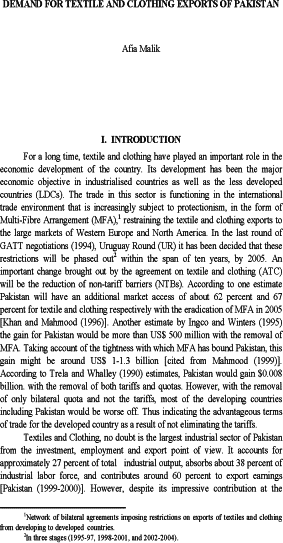
Pakistan Institute of Development Economics
- Home
Our Portals
MenuMenuMenuMenuMenuMenuMenu - ResearchMenuMenuMenuMenuMenuMenuMenu
- Discourse
- The PDR
- Our Researchers
- Academics
- Degree Verification
- Thesis Portal
- Our Portals
Demand for Textile and Clothing Exports of Pakistan
For a long time, textile and clothing have played an important role in the economic development of the country. Its development has been the major economic objective in industrialised countries as well as the less developed countries (LDCs). The trade in this sector is functioning in the international trade environment that is increasingly subject to protectionism, in the form of Multi-Fibre Arrangement (MFA),1 restraining the textile and clothing exports to the large markets of Western Europe and North America. In the last round of GATT negotiations (1994), Uruguay Round (UR) it has been decided that these restrictions will be phased out2 within the span of ten years, by 2005. An important change brought out by the agreement on textile and clothing (ATC) will be the reduction of non-tariff barriers (NTBs). According to one estimate Pakistan will have an additional market access of about 62 percent and 67 percent for textile and clothing respectively with the eradication of MFA in 2005 [Khan and Mahmood (1996)]. Another estimate by Ingco and Winters (1995) the gain for Pakistan would be more than US$ 500 million with the removal of MFA. Taking account of the tightness with which MFA has bound Pakistan, this gain might be around US$ 1-1.3 billion [cited from Mahmood (1999)]. According to Trela and Whalley (1990) estimates, Pakistan would gain $0.008 billion. with the removal of both tariffs and quotas. However, with the removal of only bilateral quota and not the tariffs, most of the developing countries including Pakistan would be worse off. Thus indicating the advantageous terms of trade for the developed country as a result of not eliminating the tariffs.



